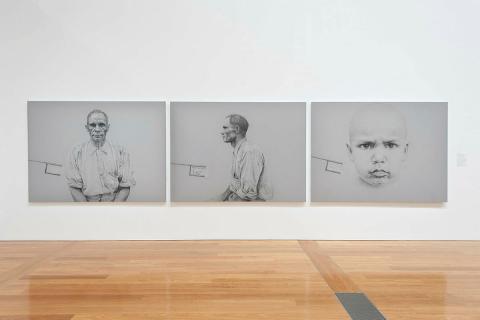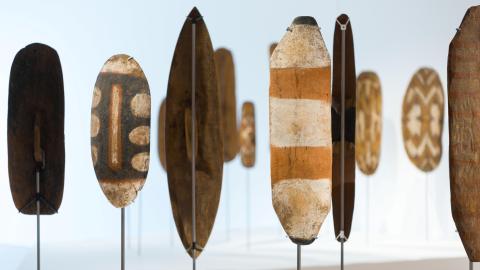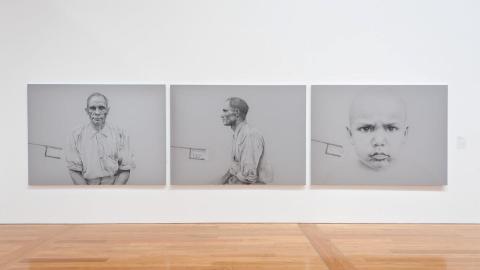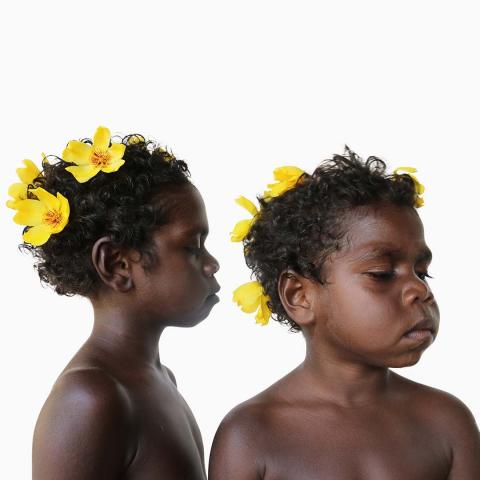ESSAY: ‘I, Object: Artworks in context’
By Adam Ford
‘I, Object’ looks at the many complex relationships Indigenous Australian artists have to objects: from the histories informing their creation, to the social and cultural consequences of their collection. Here, Adam Ford (Assistant Curator, Indigenous Australian Art), places the works featured in the exhibition in context.
Shields, boomerangs and clubs
The contemporary works of Michael Boiyool Anning, Danie Mellor, Jennifer Herd and Fiona Foley reflect the cultural estate of traditional shield-making and design. Yidinyji practitioner Michael Boiyool Anning is recognised as one of the leading Indigenous artists in Queensland to revive the tradition of making Big-uun (rainforest shields) and his three Rainforest shield 2000–01 iterations are striking examples. Traditionally, such shields were made from the buttress roots of the rainforest fig tree. Anning shapes his shields by hand and decorates them in natural ochres and ash. The painted patterns incorporate many traditional designs based on ancestral animal and plant totems. Peculiar to Anning’s region is the ‘boss’, which takes an oval shape and is located centrally on the shield. The boss is said to supply the shield with additional density, providing the hand of the holder with further protection. Anning’s hybrid designs depict handheld fish nets, scorpions and snakes, and preserve and continue the tradition of shield-making in his community. In similar inspiration, Danie Mellor also make continuous the rainforest shields of his peoples. In Topographical shield 2002, he references his Country by depicting its geographical contours in the form of a map. The complex designs are reminiscent of those used by the Jirrbal people, whose Country lies south of Mellor’s Mamu/Ngadjonji peoples. The artist’s use of recycled metal is a metaphor for the reclamation of his cultural identity and for keeping culture strong. The reclaimed metal substrate of Trunk shield II (Middle Nellie Kelly shield) 2001 likewise alludes to the displacement of his great-grandmother, Nellie Kellie (née Brackenridge), a Mamu/Ngadjonji woman, through the use of old moving cargo in its materials.

Installation view of ‘I, Object’, featuring shield and sword designs by Michael Boiyool Anning, GOMA, August 2019 / Collection: QAGOMA / © Michael Anning/Copyright Agency / Photograph: N Harth, QAGOMA
Meanwhile, the striking printworks of Mbarbarrum matriarch Jennifer Herd mark further the presence of rainforest shield in this exhibition. Herd’s inspiration for these works were the iconic rainforest shield designs of her Atherton Tableland ancestors. Her innovative patterns incorporate camouflage (comprising the silhouettes of Aboriginal people engaged in protest and dispute) and barely visible pinholes, which pierce the exposed white of the paper and reference the nineteenth-century massacres of her people by colonists such as Christie Palmerston, who described his rifle’s bullets as piercing the shields of Traditional Owners ‘as if they were sheets of paper’. In addition to shields, boomerangs and fighting clubs serve to demonstrate the wider gamut of historical Indigenous cultural production. Rare examples of clubs from the Queensland/New South Wales border region dating to the mid-nineteenth century are displayed proudly alongside boomerangs from different regions across the state.
A display of four boomerangs shows how their designs and materials were inspired by the time and place of their creation. The influence of commercial furniture-making at the Cherbourg Aboriginal Settlement can be seen in three boomerangs attributed to that community; in comparison to an original example of a boomerang made by an unknown ancestor of the Warwick area, the other objects are either more pointed in their form, are made from a soft wood that would shatter on impact, or contain fine figurative depictions of birdlife and diamond shapes (as seen in the work attributed to Jack O’Chin).
Fiona Foley’s major installation DISPERSED 2008 courageously unpacks centuries of largely unwritten Australian history in one loaded and graphic word. During the period that the British claimed ownership of Australia, it was common for settlers to drive Indigenous peoples from their Country, leading to frequent frontier violence. To hasten this process, the colonising powers established the Native Police — special law enforcement contingents frequently comprising Indigenous men from regions outside the area being occupied — to intimidate and displace resident Aboriginal communities. In this context, to ‘disperse’ became a euphemism for mass murder. For those who know this history, Foley’s intention is clear: her sculpture is a monument to Aboriginal people killed in these conflicts. For those unaware of this history, the artwork is a prompt to reconsider our shared and contested past, and to stand in its entire and ugly view. Like Indigenous peoples, our cultural objects were also ‘dispersed’.

Fiona Foley / Badtjala people, Wondunna clan, K’gari (Fraser Island) / QLD Australia b.1964 / DISPERSED 2008 / Purchased 2013. Queensland Art Gallery | Gallery of Modern Art Foundation / Collection: QAGOMA / © Fiona Foley / Photograph: N Harth, QAGOMA
Wik and Kugu sculpture
These utilitarian objects are contrasted by the ongoing sculptural traditions of Wik men from Aurukun, in western Cape York, in the state’s north. They celebrate unbroken customary traditions in artworks Apelech brothers 2002 and Kalben 2016–17 by Wik-Alkan artist Craig Koomeeta and Wik-Mungkan artist Alair Pambegan, respectively.
In the 1940s and 50s, ceremonial wooden sculptures from Aurukun were collected by museums and popularised. Many Wik and Kugu men continue to make these traditional objects, constantly reinventing their artistic heritage through the sculptural medium. Koomeeta’s sculpture depicts a significant creation story integral to all five ceremonial groups of the Wik people. Apelech means ‘clear water’ in the Wik-Mungkan language and refers to the settling of sediments in the sea at the end of the wet season. In keeping with this narrative, the dots on the carvings represent sparkling water and invoke the ceremonial designs painted onto the bodies of the performers who enact this dance. The full name of the titular brothers is Pul-Uchan, which means ‘two initiates’ in Wik-Mungkan. The younger of the two — the shorter figure with white spots — is from the coastal area, while the older brother — the taller figure with banded body designs — is from inland. The white, pointed spikes that protrude from the arms of the older brother represent stingray spines, which the Wik use to decorate spears.
Alair Pambegan’s lively installation represents Kalben, a site on Tompaten Creek near its junction with the Watson River, south of Aurukun, which follows the brotherly theme. The work shows the Kalben customary story of two young initiate brothers breaking a food lore; upon eating bat, a forbidden food, which they cooked in a ground oven, the brothers were swarmed by bats and taken up into the Milky Way, where they remain as two black patches in the night sky

Installation view of ‘I, Object’, featuring (l–r) Alair Pambegan’s Kalben 2016-17, David Marpoondin’s Sitting ku' (camp dog) 2009 and Ku' wu'nan (Lying camp dog) 2010, and Roderick Yunkaporta’s Ku' (Camp dog) 2010 and Scratching ku' (camp dog) 2010, GOMA, August 2019 / Collection: QAGOMA / © The artists / Photograph: N Harth, QAGOMA
The body
The final frontier of ‘I, Object’ is the Aboriginal body-as-object: works that relate to the control of Indigenous peoples and, macabrely, the museological collection of Aboriginal bodies for scientific purposes. Historically, skeletons of deceased Aboriginal people were taken from sites of conflict or were stolen from sites of burial or interment, and then sent to countless museums throughout the Western world. Today, numerous natural and social history museums still house thousands of unreturned Aboriginal remains, despite decades of repatriation efforts.
Kamilaroi artist Warraba Weatherall’s To know and possess 2021 memorialises ten cultural artefacts, including the human remains of three ancestors, which are held in national and state galleries around Australia. Weatherall has chosen to cast the original museum labels for this material as individual bronze plaques. These commemorative works honour the objects and list their method of acquisition and categorisation, while raising questions about the circumstances of their removal from Country. With them, Weatherall critiques the institutions that seek to ‘protect’ these cultural objects by keeping them in secure environments, demonstrating that this act of safekeeping has also kept them from their intended uses and the descendants of their makers.

Following a similar anthropological/museological thread, Body of objects 2016 by Bidjara/Ghungalu/Garingbal artist d harding offers replicas of Aboriginal artefacts belonging to the artist’s family, which they have cast in medical-grade silicone. For harding, these replicas — spears, boomerangs, and various forms of nulla-nulla (clubs) — evoke Aboriginal cultural objects taken from their makers by non-Indigenous collectors for display in museums and galleries. harding’s reproductions slump over plinths in a surrealist manner; their dark forms often studded with nails and other metal embellishments. In this sense, harding critiques both the fraught histories of material culture within institutions, and the way in which modernist artists fetishised these objects and their cultures of origin.
While Weatherall and harding’s works memorialise Indigenous peoples, they too point at Indigenous objectification: a process by which Aboriginal peoples are reduced to objects and through which they internalise the objectifying observer’s perspective of their own selves.
Take Girramay/Yidinyji/Kuku Yalanji artist Tony Albert’s whiteWASH 2018, for example. This installation follows one of Albert’s main currents of investigation: depictions of Aboriginal peoples and cultural practices on commercial objects. Over two decades, Albert has amassed a large group of these ‘collectables’, including vintage ashtrays, which he reclaims, repurposes, and calls ‘Aboriginalia’. His work questions the generally accepted view that these representations are justified as a kind of homage, and the notion that the items are ‘of their time’ and therefore acceptable. Albert considers these notions as a form of ‘whitewashing’, which he subverts by bringing the artefacts together to encourage viewers to consider their loaded racial histories — including the metaphorical, and literal, stubbing out of a cigarette on a culture.

Installation view of ‘I, Object’, featuring (l–r) Tony Albert’s whiteWASH 2018 and Brook Andrew’s Sexy and dangerous 1996, GOMA, August 2020 / ©The artists/Copyright Agency / Photograph: C Callistemon, QAGOMA
Countering similar inherited stereotypes, in her ‘A Warrior without a Weapon’ series 2018, Kaantju/Umpila artist Naomi Hobson defies negative representations of Australian Indigenous men in the public domain by affirming their capacity for caring. Hobson has witnessed firsthand the harm that this stigmatising can cause and worked with men from her Coen and Lockhart River communities to produce this series. Significantly, many Christian evangelists introduced restrictive gender roles to Indigenous communities through the ‘missionisation’ of First Nations people; because of these imposed values, much of the cultural adornment practised by Kaantju and Umpila men ceased. By photographing her male subjects decorated with flowers, Hobson reinvigorates this aspect of her culture.
Engaging also with the photographic medium — understood here as a tool used in the objectifying field of anthropology — is Kuku Yalanji/Waanyi/Yidinyji/Guugu Yimithirr artist Vernon Ah Kee. In the triptych neither pride nor courage 2006, Ah Kee renders his son and grandfather — who are accompanied by glass slides detailing their language group — in charcoal, crayon and paint. These historical portraits reference the work of anthropologist Norman B Tindale (1900–93) who, between the 1920s and early 1960s, photographed Aboriginal peoples from communities throughout Australia and recorded their genealogies. In 1974, Tindale published these images in his landmark study ‘Aboriginal Tribes of Australia: Their Terrain, Environmental Controls, Distribution, Limits and Proper Names’. While Tindale’s photographs are now available to the subjects’ descendants, the images themselves are often cropped when displayed in museums to minimise their clinical, ethnographic qualities. Ah Kee has explained that he wanted to interrogate this practice, and to transform the portraits into images that foreground the beauty and humanity of Aboriginal peoples, allowing his son to be categorised by his tribal groups — a privilege his grandfather was not afforded.

Bidjara artist Christian Thompson explores a similarly revivalist thread. In his work Refuge 2015, Thompson builds on his previous performance video, Dhagunyilangu (Brother), for which he composed a song in his Bidjara language that was sung acapella by a classically trained European soloist. The song’s chorus, ‘Dhagunyalingu, Wugu Wadya Dhungangha’, translates as ‘Brother, come with me tonight’. In Refuge, Thompson himself sings the song, but in a more popular style set to a musical score. The tenor of his voice resounds with both sadness for a language on the cusp of extinction and defiance born from his resolve to preserve the idiom. Thompson’s adaptation of a popular Western tune with piano and percussive accompaniment speaks to the hybridisation and rebirth of languages and cultures, and the often-subversive strategies their speakers need to adopt to maintain them.
For Indigenous Australians, objects are loaded with the histories informing their creation, as well as the social and cultural consequences of their collection. This exhibition considers not only the many complex relationships Aboriginal and Torres Strait Islander peoples have to objects but also how the Indigenous body is treated as an object — is objectified — in museum collections across the world and in everyday life. Works here exhibited have been selected for celebrating the survival of Queensland Indigenous sculptural practices, for bearing witness to the revival of regional Queensland mark-making traditions, and for mourning the cultural loss or life of objects when they are removed from their original communities. Together, the featured artworks coalesce to demonstrate the powerful and ongoing presence of Queensland Indigenous cultural practitioners.
Essay by Adam Ford (Nyoongar), Assistant Curator, Indigenous Australian Art, QAGOMA.
‘I, Object’ was on display at GOMA from 3 Aug 2019 to 29 Aug 2021, and tours regionally from 5 Aug 2023 to 30 Mar 2025. Explore ‘I, Object’ in 3D, as it was installed in the Gallery of Modern Art.
Explore the artworks

neither pride nor courage 2006
- AH KEE, Vernon - Creator

whiteWASH 2018
- ALBERT, Tony - Creator

DISPERSED 2008
- FOLEY, Fiona - Creator

Apelech brothers 2002
- KOOMEETA, Craig - Creator

Body of objects 2016
- HARDING, D - Creator

Topographical shield 2002
- MELLOR, Danie - Creator

Kalben 2016-17
- PAMBEGAN, Alair - Creator

Refuge 2015
- THOMPSON, Christian - Creator

To know and possess 2021
- WEATHERALL, Warraba - Creator

Boomerang c.1940
- O'CHIN, attrib. to Jack - Creator



